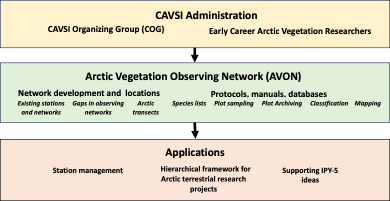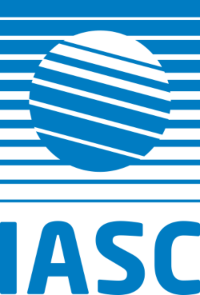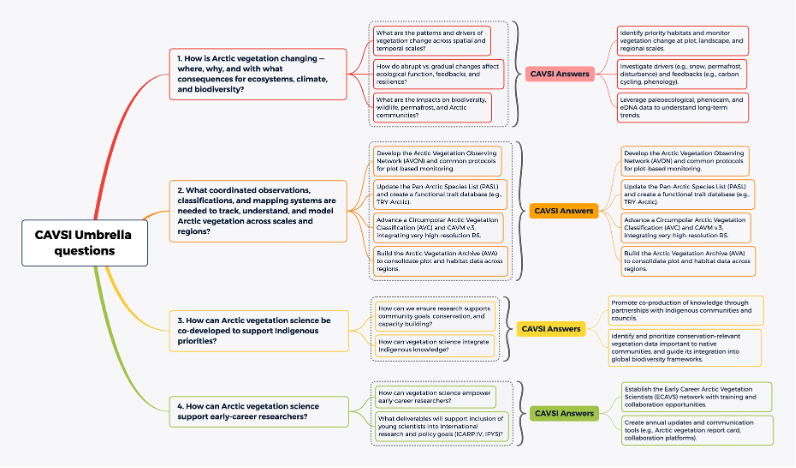Project Report
The Circumpolar Arctic Vegetation Science Initiative (CAVSI) is an international Arctic research effort motivated by widespread and accelerating changes to Arctic vegetation and the need to understand their ecological, climatic, and biodiversity impacts. The goal is to build an Arctic Vegetation Observing Network (AVON) that includes ground observations, mainly at existing sites where there are permanent vegetation plots, and to develop shared archives of plot vegetation and environmental data and vegetation maps - to improve models, support biodiversity assessments, and inform global change research. A key component of CAVSI is to support and train the next generation of Arctic vegetation scientists through mentorship, collaboration, and shared research.
CAVSI is a response to the needs expressed by ICARP IV Research Priority Teams 1 and 2, which focus on the role of the Arctic in the global system and observing, reconstructing, and predicting future Arctic climate dynamics and ecosystem responses. infrastructure. The initiative creates a framework to answer where and why Arctic vegetation is changing – or remaining stable – how these patterns affect ecosystem function and feedbacks, and what scalable observation systems are needed to track and model them.
A 3-day CAVSI workshop at ASSW 2025 was attended by 85 participants from 15 countries. Prof. Ladislav Mucina presented the keynote address titled “Vegetation complexity of the Arctic-Alpine realm at disparate spatial scales”.
The workshop participants first defined the priority vegetation science questions that need to be addressed by the community of terrestrial Arctic researchers in the next decade. The questions fell into seven broad topics: Landscape dynamics and change; biodiversity monitoring and mapping; climate change and disturbance regimes; functional ecology and biotic-abiotic interactions; community engagement and indigenous knowledge; and data integration and collaborative frameworks.
Seven panels of experts addressed the following issues: (1) Training the next generation of arctic vegetation scientists; (2) Learning from large pan-Arctic networks or programs; (3) Learning from vegetation-focused Arctic networks or projects; (4) Pan-Arctic species lists and local floras; (5) Sampling and archiving protocols for Arctic plot data; (6) Vegetation classification; and (7) Vegetation mapping and remote sensing. 
Each panel developed several recommendations that were summarized in the final Workshop Resolution that included nine priority research items:
1. Establish a Circumpolar Arctic Vegetation Science Initiative (CAVSI) to help address priority vegetation-related science questions across disciplines and a hierarchy of spatial scales in relationship to, for example: landscape dynamics and change, biodiversity monitoring and mapping, climate change and disturbance regimes.
2. Establish an early career vegetation scientists’ network to foster career development in Arctic vegetation-related disciplines to promote Arctic vegetation-science-related education and training activities, and develop cross-disciplinary and cross-cultural connections with other Arctic-related early-career groups.
3. Develop an Arctic Vegetation Observation Network (AVON) within existing interdisciplinary observing networks to (1) aid in site and project management and development of comparable frameworks for locating and tracking vegetation plot data and mapped information, (2) promote long-term sustained observations at well-marked permanent vegetation plots and mapped areas; (3) coordinate vegetation observations with other Arctic system observations; (4) identify geographic and topical gaps for sampling, archiving, classifying, and mapping Arctic vegetation, and (4) establish new observatories in understudied vegetation-habitat types and regions.
4. Update, maintain, and publish a Pan Arctic Species List (PASL) and local floras (complete species lists, including vascular plants, bryophytes, and lichens) at Arctic research stations and other research sites.
5. Adopt standardized protocols for vegetation and environmental plot surveys that are widely used by the international vegetation science community, that include traditional plot survey methods, and where feasible, use new transformative methods appropriate for observing, modeling, reconstructing, and predicting Arctic vegetation change.
6. Develop regional Arctic vegetation archives for vegetation plot data and map data and merge the regional archives into a circumpolar Arctic Vegetation Archive (AVA), including methods to harmonize and standardize the data.
7. Develop local, regional, and circumpolar Arctic vegetation classifications (AVCs) and checklists of classified vegetation units based on standardized approaches developed by the international community of vegetation scientists, including crosswalks to equivalent units in other regional and national classification approaches.
8. Revise, edit, and publish a new version of the Circumpolar Arctic Vegetation Map (CAVM v. 3) with increased resolution and a hierarchical legend approach that can be applied to maps at global, regional, landscape, and plot scales.
9. Apply the products of CAVSI to priority ICARP IV and IPY-5 research topics.
A CAVSI White Paper includes a framework for vegetation description and monitoring. It includes: (1) a network of sites across the full range of Arctic climates, phytogeographic regions, local habitats, and disturbance regimes; (2) standardized methods to describe and monitor local floras, vegetation composition, and key environmental factors; (3) a pan-Arctic vegetation plot archive to store legacy and recent plot data; (4) a consistent hierarchical classification and checklist of Arctic vegetation; (5) an archive of Arctic vegetation and landcover maps; (6) applications and ideas for CAVSI IPY5 initiatives; (7) an 11-year timeline for CAVSI activities leading up to and including synthesis from IPY5 activities; (8) recommendations for priority research activities; and (9) Five appendices containing: (i) List of CAVSI Workshop participants; (ii) CAVSI Workshop agenda; (iii) Keynote address by Prof. Ladislav Mucina abstract; (iv) Summaries of the seven panel discussions and breakout groups, (v) Resolution of the CAVSI workshop.
In addition, two CAVSI science sessions were held on March 25 and 27: Science Session 2.6 “Back to the Future II: Linking past and future IPY terrestrial biodiversity efforts, and Science Session 2.8, “Building a time machine out of a Delorean: Observing, reconstructing, and predicting vegetation change in the Arctic”. Forty-one oral and poster presentations are included in the proceedings volume from these sessions (in progress).
Scientific Highlights
- The three-day CAVSI workshop and two CAVSI science sessions that occurred during Arctic Science Summit Week, March 20–28, 2025. Eighty-five workshop participants attended the workshop, including online participants, from 15 countries. Including the distribution of the hard-copy raster versions of the Circumpolar Arctic Vegetation Map (CAVM Team 2024).
- CAVSI White Paper This document provides a framework for vegetation description and monitoring. It includes: (1) a network of sites across the full range of Arctic climates, phytogeographic regions, local habitats, and disturbance regimes; (2) standardized methods to describe and monitor local floras, vegetation composition, and key environmental factors; (3) a pan-Arctic vegetation plot archive to store legacy and recent plot data; (4) a consistent hierarchical classification and checklist of Arctic vegetation; (5) an archive of Arctic vegetation and landcover maps; and (6) applications and ideas for CAVSI IPY5 initiatives, (7) an 11-year timeline for CAVSI activities leading up to and including synthesis from IPY5 activities, and (8) recommendations for priority research activities.
- CAVSI Science Sessions Proceedings Volume (in progress). This document includes the illustrated abstracts from 41 oral and poster presentations at Science Session 2.6 “Back to the Future II: Linking past and future IPY terrestrial biodiversity efforts, and Science Session 2.8, “Building a time machine out of a Delorean: Observing, reconstructing, and predicting vegetation change in the Arctic”.
Date and Location:
21 – 18 March 2025 | Boulder Colorado, US (ASSW2025)
IASC Working Group / Committees funding the Project:
- Terrestrial WG
Project Lead
Donald A. Walker, University of Alaska Fairbanks, USA
Year funded by IASC
2024
Project Status
Completed

